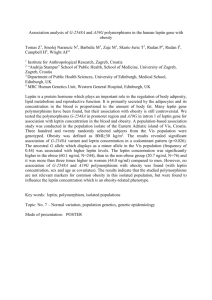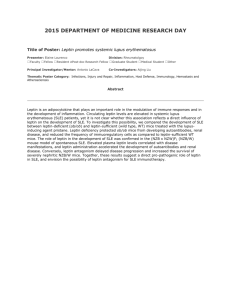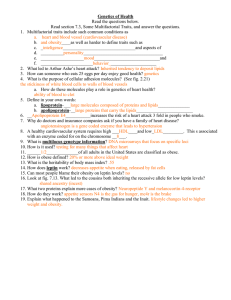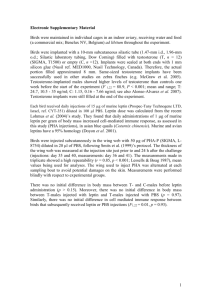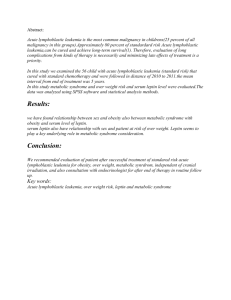-
advertisement
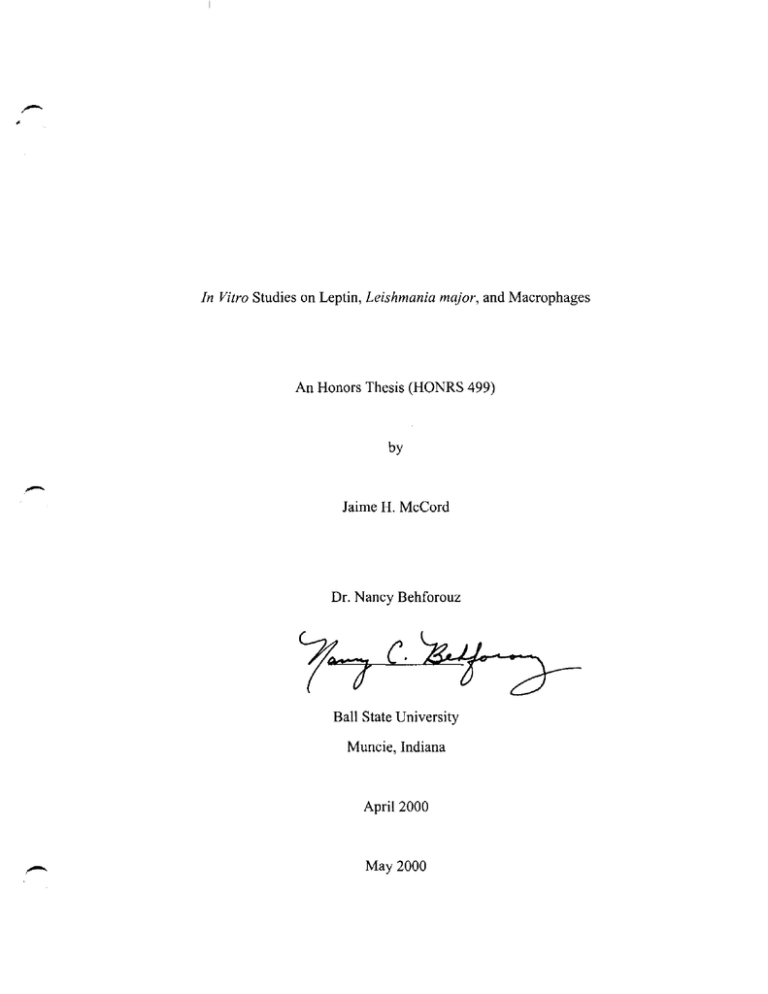
In Vitro Studies on Leptin, Leishmania major, and Macrophages An Honors Thesis (HONRS 499) by - Jaime H. McCord Dr. Nancy Behforouz Ball State University Muncie, Indiana April 2000 - May 2000 :- f (0(1 ,l,...,--, - -~ L-') !. Li '11 Abstract • J'v\ -_' '; The purpose of this study was to determine the effect of leptin on macrophage function in vitro. Peritoneal macrophages were cultured from young mice and phagocytosis of Leishmania major, an obligatory intracellular pathogen of mononuclear phagocytes, was measured in the presence or absence of varying concentrations of leptin. Phagocytic activity was measured by counting the number of intracellular amastigotes as well as the percentage of infected cells. We also evaluated the effect of Ieptin alone on the survival of L major by exposing the promastigotes in vitro to differing leptin concentrations and monitoring their proliferation. An experiment performed to establish optimum condidtions for macrophage/Leishmania culture was successful in establishing culture and infection conditions for future Ieptin experiments. Unfortunately, several experiments designed to observe the effect of leptin on the macrophage/Leishmania interactions were essentially unreadable. All cells appeared to have been overrun with L major and had burst as a result. Large, abnormal coaIescences of macrophages were also observed, but only in the leptin exposed cultures implicating leptin as the cause. In other experiments, leptin showed a direct inhibitory effect on L major growth and this inhibition appeared to be irreversible. - Introduction Leptin, a 16 kD protein, was discovered in 1994 by Zhang et al. Lack of this hormone is responsible for the phenotype seen in ob/ob mice. Leptin injections given to these mice led to increased metabolic activity and weight loss (I). As a result, leptin initially generated much interest as a potential treatment for human obesity. Located on chromosome 6 in mice and 7q31.3 in humans, the ob gene encodes for a 167 amino acid product that is synthesized solely in adipocyte cells and has all the features of a secreted protein (2). While the amino acid sequence ofleptin bears no resemblance to any other growth factor or cytokine family, its tertiary structure has been unmistakably identified as a member of the hemapoietic cytokine fumily that contains a four alpha helix bundle fold. Two conserved cysteine residues in the leptin chain are involved in an intrachain - disulfide bond found to be critical in maintaining its structural integrity and stability. When a leptin variant unable to form this disulfide link was given to ob/ob mice, a biological response occurred which corresponded to other studies which reported reduced activity for IL-4, GM-CSF, and IL-6 due to helical cytokine instability caused by unfolding (3). Leptin behaves as a classic endocrine hormone, but just as molecular modeling predicted a tertiary structure for it similar to many hemopoietic cytokines, the leptin receptor has also proved to be a member of the hemopoietin or cytokine receptor fumily (4). The receptor for leptin has both long and short isoforrns that are encoded for by mRNA's in a variety of human and murine hemopoietic organs, but in most cases, only the long form receptor, expressed most abundantly in the hypothalamus, is capable of signaling proliferation and differentiation in hemopoietic cell lines (5). Mutations in the leptin receptor gene, located at the db locus, are responsible for the obese phenotype seen - in db/db mice due to abnonnal splicing of the long form ofOB-R generating a shortened receptor resembling the inactive short form (6). Recent studies revealed that a similar - mutation could occur in the human OB-R resulting in early-onset morbid obesity and no pubertal development (7). In addition, the leptin receptor has been found to be nearly identical to B219, a proposed hemopoietic receptor expressing patterns that indicate involvement in hematopoietic and reproductive function (8). While the role of leptin in hematopoiesis is only beginning to be investigated, its primary role as a metabolic regulator has been studied for some time now. Essentially, leptin provides information to the hypothalamus about the amount of body fat, thereby modulating CNS functions that regulate food intake and energy balance. In studies conducted on obese and normal weight individuals, serum leptin concentrations were found to be much higher in obese subjects. While several factors may have contributed to the elevated concentrations, in humans it appears that serum leptin concentrations correlate most highly with the amount of adipose tissue in the body (9). -- In both human and animal models, weight loss results in a decrease ofieptin while weight gain leads to increased levels indicating that the hormone is synthesized and released in the obese. However, if leptin is abundant then appetite should increase and energy expenduiture should increase leading to weight loss. The fuct that this result is not observed though suggests that obese humans are actually leptin resistant (10). While adipocyte-derived hormones are proportional to fat mass, they may be lowered rapidly by fasting or increased by inflammatory mediators (11,12). This fact has led researchers to explore the link between leptin levels and the immune response. Since humans of low body weight are characterized by having impaired cell-mediated immunity and reduced levels ofieptin, the question arises of whether those in a starved state are predisposed to death from infectious diseases from simply being malnourished or because there is an actual effect on cellular immune function (13). Leptin has been found to have a specific effect on T -lymphocyte responses by - differentially regulating T-cell proliferation resulting in increased Thl and decreased Th2 cytokine production. In mice suffering from acute starvation, the starvation-induced - inhibitory effects on T-cell priming could be completely reversed upon injection of leptin (14). In vitro findings indicated that leptin could modify T-cell responses directly. Surrounding these results was the hypothesis that fulling leptin levels alerted the body to the impending state of starvation and signaled it to begin conserving energy. This energy was then preserved for more vital body functions, such as respiration and the central nervous system, rather than used for the less essential reproductive system or the immune response, which requires large scale T-cell expansion and high energy expenditure. The administration of leptin to malnourished individuals as therapy has been considered but the question then arises of whether leptin-dependent immunosuppression is adaptive (like suppression of metabolic rate), or whether it is an unintended physiologic consequence offopd deprivation. In the context of immune function, it seems beneficial to treat malnourished individuals with leptin, but in the context of - starvation it seems logical that increased leptin would diminish appetite, increase energy expenditure and decrease energy storage leading to further complications in the health of the individual (15). The role which leptin plays in the immune system, however, goes fur beyond these findings linking it to cell-mediated immunity. The leptin receptor is widely distributed in the body and has been found in hemopoietic cells having signaling capabilities similar to IL-6-type cytokine receptors (16). As a result, a role for leptin in hematopoiesis has been proposed. Leptin seems to have the proliferative effect of a multilineage progenitor, stimulating increased myelopoiesis, erythropoiesis, and Iymphopoieis. While the leptin receptor seems to be expressed on more mature hematopoietic cells, studies indicate that it could act on very early cells in the hematopoietic lineage. In addition, human stem cells expressing the CD-34 antigen were - found to express both the long and short form of the leptin receptor (17). In studies done on murine bone marrow, leptin induced only granulocyte -macrophage (OM) colony formation, displaying activity similar to OM-CSF, while other - colonies were not detected. A synergism between leptin and stem cell factor was also observed showing that leptin helps in the proliferation of hematopoietic progenitors in vitro (18). Thus, leptin may be a critical hormone in hematopoeisis, even affecting stem cells and progenitor cells. Although leptin receptors were found on early granulocytes and monocytes and in higher numbers on lymphocyte-like cells that could be stem or progenitor cells, leptin was not able to stimulate clonal proliferation in semisolid cultures or enhance responses to other cytokines (19). But leptin was found to stimulate proliferation and functional activation of human circulating monocytes in vitro by inducing production of1NF-a and IL-6 (20). Leptin was also found to stimulate peritoneal cell populations to produce higher levels ofGM-CSF and G-CSF (21). In a functional assay, human leptin was also shown to increase phagocytic activity of murine peritoneal macrophages toward - Leishmania major (21). Leptin-treated rnacrophages were found to display a higher number of attached promastigotes after infection with the parasite. This increased attachment could be mediated by an up-regulation of macrophage receptors for the parasite, such as CRI and CR3, or by increased phagocytic activity. In our experiments, we attempted to determine whether this observation is valid and if murine leptin does have a stimulatory effect on macrophage function resulting in increased phagocytosis and clearance of L. major in vitro. We also examined the direct affect ofieptin on the L. major parasite in an in vitro growth assay. The activity ofieptin in this realm of immune function is relatively new and warrants further study and exploration. Materials and Methods Experimental Animals Three to five month old male and female BALB/C mice were used from the breeding colony maintained at Ball State University. These mice were housed and fed under conditions meeting the approval of the Ball State University Department of Biology. Solutions and Reagents Cells were cultured in RPMI media with penicillin, streptomycin, antimycotic, hepes, and sodium bicarbonate, and 10% FBS. Recombinant murine leptin produced in E. coli was purchased from Sigma Chemical. Leishmania major was grown at pH 7.2 in medium 199 containing Hanks' salts and L-glutamine with added hepes, penicillin, streptomycin, and sodium bicarbonate and 20% FBS. Hanks' buffered saline solution was used for washing the cells. Culture of Resident Peritoneal Macrophages Mice were sacrificed by cervical dislocation and then wetted with 90% alcohol. The skin on the lower abdomen was clipped with sterile scissors and forceps to reveal the peritoneal area. Using a 10 ml syringe with a 20 gauge needle, approximately 7 mlof HBSSmedia was injected through the belly wall. A tent was made with the forceps and 6-8 ml of injected fluid was drawn up and the collected cells were placed in a 50 ml - sterile centrifuge tube. Another 6-7 mls was injected into the cavity, withdrawn, and added to the previously collected cells. The cells were spun in a floor centrifuge, - decanted, re-suspended in 4-5 mls ofHBSS, and re-centrifuged for 10 minutes. Once decanted, the cells were re-suspended in 1 ml of 10 % FCS-RPMI and adjusted to 2.5 x 10"6/ml or 5 x 10A6/ml. 0.4 ml of cells were added to culture wells on two 8-chamber Lab-Tek Tissue Culture Slides and allowed to adhere overnight at 37° C in a C02 incubator. The cells were then washed twice with HBSS to remove non-adherent cells. Infecting Procedure Adherent cells were infected with 0.3 ml of either 1 x 1OA7/ml or 1.5 x 1OA7/ml promastigotes washed twice in 10% FCS-RPMI. The slides were incubated for 2 hrs at 37 C, 5% C02 and then washed three times with HBSS to remove free promastigotes. 0.4 ml of 10% FCS-RPMI with either 100 ng/ml or 50 ng/ml of leptin was added to each well and the slides were incubated for either 24 or 48 hrs. The slides were then removed from the incubator, washed once with HBSS and allowed to airdry. After fixing the slides in absolute methanol they were stained in Giemsa for 1-2 hrs. The slides were read by counting the total number of macrophages per field, the number of infected cells and the number of phagocytized L.major per field. Leishmania Growth Curve Procedure The direct effect ofleptin on L. major in the early stationary phase was also assayed. 2-fold serial dilutions ofleptin in 199 media were made starting at 200 ng/ml and ending at 12.5 ng/ml. 1.8 ml of 199 + 20% FCS + leptin was added to five of the six test tubes in duplicate. Two tubes containing no leptin was used as controls. 0.2 ml of L. major at a concentration of 1 x 1QA7/ml was added to each tube and then the tubes were - incubated at room temperature. At three days and six days, counts were made of the L. major to determine proliferation compared to the control and to see the effect ofleptin on the growth pattern. Another experiment with a short leptin pulse was also performed with the same initial L. major concentration but with either medium alone, 100ng/ml, or SO ng/m\ concentrations ofleptin. In this assay, the L major were incubated in the 199 media + 20% FCS + leptin at room temperature for only three hours and then centrifuged for 10 minutes at 35 rpm, decanted, and re-suspended in 199 + 20% FCS without leptin. The control cultures with no leptin were treated in the same manner. All cultures were allowed to incubate at room temperature and at three days and six days counts ofthe parasites were made. Results - Determination of the effect of /eptin on macrophage activity. We attempted to determine if leptin has an effect on macrophage anti-Ieishmanial activity by exposing the cells to differing concentrations ofleptin following a three hour infection period. We incubated the cells in media containing leptin concentrations of 100 ng/rnl and SO ng/rnl. Cells in the controls as well as those exposed to both leptin concentrations did not exhibit controlled uptake of the L. major, but rather appeared to be overrun by the parasites resulting in destruction ofthe cell. The parasite/macrophage ratio appeared to be much too high probably due to too few macrophages in the cultures or too many L. major. The leptin also _:med to cause large coalescence of macrophages compared to that observed in the control wells. Overall, there were more cells per field when leptin was used but those cells did not appear normal. Determination of baseline macrophage activity. While the experiments involving the use - ofleptin did not produce readable results, an identical experiment done without leptin was successfill allowing for optimization of culture conditions. Two different concentrations of macrophages were used as well as two different concentrations of L. major. The cells were incubated for either 24 or 48 hours after infection with the parasites. Macrophage activity was quantified by counting approximately 15 fields of cells for the differing concentrations of macrophages and parasites for each slide (either 24 or 48 hrs). The number of rnacrophages, the number of L. major phagocytized and the number of infected cells in each field was counted and then those numbers were averaged and used to determine percentage of infection and the average number of L. major phagocytized per cell. In Figures 1 and 2, infection percentages for macrophage concentrations of2.5 X 10"6/ml and 5 X 10"6/ml, respectively, are shown. At the lower cell concentration there was not a significant difference in the percentage of infected cells between the 24 hr and 48 hr periods of incubation when 1 X 10"7/ml L. major was used (- 60%). However, in - the cultures containing 5 X 10"6 macrophageslml, higher L. major concentration did infect more cells initially (83%)(Fig. 1). This percentage fell after 48 hours to 66%. Using a higher macrophage concentration, there was a greater increase in the infection percentages between the two incubation periods with the lower L. major concentration (Fig. 2). This increase is difficult to explain since the number of L. major per macrophage was constant or decreasing over time. Perhaps there was a counting error or other problem with these fmdings. When the cells were viewed through a microscope under oil immersion, there was an observable difference in the appearance ofthe fields at different concentrations of macrophages and L. major. The higher macrophage concentration presented fields that were often crowded with cells, averaging 25-30 per field, compared to 10-15 cells per field at the lower concentration. In addition, the higher L. major concentration resulted in more cells becoming overrun with the parasites, making it difficult to accurately count - how many had infected the cell. But the higher macrophage concentration seemed to control the range of L. major uptake better resulting in a more even distribution of the - parasites within the cells. In Figure 3, with the lower macrophage number there appears to be an increase in numbers of L. major per cell which may indicate that the parasites were replicating in the infected cells. At the higher infection dose, however, the numbers of parasites/cell actually decreased indicating clearance of L. major from the cells. Taken together with the drop in percentage of infected cells under these conditions (Table I), it may be that these cells were activated sufficiently to destroy some of their intracellular parasites after 48 hrs. Interestingly, with a higher macrophage level, this evidence of activation was not seen as there was no significant drop in percentage of infection or number of parasites/macrophage (Table I and Fig. 4). Determination of the effect of leptin on the growth and survival of L. major. In an in vitro growth assay, L. major promastigotes were exposed to varying concentrations ofleptin for a total of six days. At 3 days and 6 days, the parasites were counted on a hemacytometer and the numbers obtained at each concentration were averaged since the experiment was run in duplicate. In Figure 5, the growth patterns observed during this six day incubation period are shown. The data shows that concentrations of leptin above 25 nglmI had a significant effect of the growth and survival of the parasite. At 50 ng/mI, L. major growth was half of that seen in lower leptin concentrations at the 3 day mark, and at 6 days, growth seemed to be severely stunted. At the highest concentration of200 ng/mI, L. major was barely surviving at 3 days and by the sixth day, those that had been living were now dead. When counting the L. major there was also an observable difference in their motility at concentrations above 25 nglml. The parasites were much more sluggish at these concentrations and activity was greatly reduced. - To determine if the effect leptin had on L. major was reversible, another in vitro growth assay was set up, but this time the parasites were only pulsed with leptin for a three hour period and then allowed to incubate in leptin-free media for six days. While - growth was not as severely inhibited as that seen in the above experiment, the brief exposure to leptin did have some irreversible effect on the parasite. Initially, the growth of the pulsed L. major was similar to the control, however after 3 days, the organism seemed unable to continue proliferation at this rate and by the sixth day, growth decreased by over halfthat seen in the control (Fig. 6). Discussion Based on these resuhs, it seems that it would be best to use a macrophage concentration of 5 X 101\6/rnl in experiments with I X 101\7/rnl L. major and leptin, as this concentration of cells demonstrated approximately a 40-70 % infection rate with an average of about 4.5 L. major/infected cell after 24 hrs and gave a good monolayer of countable cell~. By using a concentration of cells that are more susceptible to significant increases or d,~creases in infection by L. major, the effect ofleptin on cell activity could be more easily measured. The results of the in vitro growth assays proved to be significant in evaluating the conditions used for testing the effect ofleptin on macrophage activity. In the paper by Gainsford et al. which was mentioned in the introduction, the researchers reported that "Ieptin-treated peritoneal macrophages displayed higher numbers of attached promastigotes after 1 hour of infection compared to untreated controls." These findings may seem to indicate an enhancing effect by the leptin on macrophage activity, but based on the results of the growth assays, other factors may need to be considered. One major factor is that these researchers infected the macrophages with L. major in the presence of leptin at a concentration of 50 ng/rnl. In the assays, 50 ng/ml of leptin was shown to have - a significant effect on the growth and motility ofthe parasite. In humans, mean serum levels ofleptin run between 7.5 ± 9.3 ng/rnl in normal individuals and 31.3 ± 24.1 in - obese individuals (9). Thus, the inhibitory levels ofieptin observed in this study are physiologically relevant. This observation warrants the consideration that the increased phagocytosis observed in the cells was not due to leptin's effect on the macrophages but rather its effect on L. major. Since macrophages can phagocytize dead or non-motile organisms much better than those that are living, perhaps the leptin stunned or killed the parasites making them much easier prey for the macrophages resulting in the higher numbers of attached promasitgotes observed by the researchers. The dramatic effect of leptin on the growth and motility of L. major was not expected, however, this effect must now be considered in future experiments involving L. major, macrophages and leptin. It seems counterintuitive to conduct experiments that expose macro phages to leptin during the infection process as the leptin may have an unwanted direct effect on L. major. While the experiments involving leptin and -- macrophages did not provide reportable resuhs, an outgrowth ofthis experimental system in the form of the in vitro assays of L.major and leptin did provide valuable data regarding the effect of leptin on living organisms. If nothing else, it showed that there is still much work to be done regarding leptin, L. major, and macrophage activity. -- ) ) ) Figure 1. Percentage of Infected Macrophages at 2.5 X 10A6/ml ----.-------------1 90 .!!l Gi (,) -"'C ~ CD U CD c -- ; .1.5 X 1.QA7/mll 40 '0 c~ . 01 X 10A7/ml 30 20 10 0 48 hrs 24 hrs Incubation Period ) ) ) Figure 2. Percentage of Infected Macrophages at 5 X 10A6/ml -~l 90 80 70 ~ 60 CI) U "t:I CI) 50 01 X 10"7/mll I .1.5 X 10"7/ml j 0 ~ c: 40 0 :::!! 0 30 20 10 0 48 hrs 24 hrs Incubation Period ) ) ) Figure 3. Uptake of L. major by Macrophages at 2.5 X 10A6/ml /.-------- - ._----------- - - - - - - - -~-.- .. -~----------. ~ , 6 5 (jj .g .-mo E D 1 X 101\7/ml .J o .1.5 X 101\7/ml! '*" Cl ~ 2 1 o 48 hrs 24 hrs Incubation Period 1 ) ) ) Figure 4. Uptake of L. major by Macrophages at 5 X 10A6/ml 6 5 Gi (J 4 -.: .-0co E .J - 31 0 '1=1: 101 X 10'7/ml II ~1.5X10'7/ml CI «> 2 1 o 48 hrs 24 hrs Incubation Period ) ) ) Figure 5. L. major Growth Patterns in Leptin --.-~-~~~-- 10 8 7 6 L. major Concentration (X 10"5/ml) 5 103 days I [.6 days L __ -----' 4 2 1 o o 12.5 25 50 Leptin Concentration (ng/ml) 100 200 ) ) ) Figure 6. L. major Growth Patterns After Three Hour Leptin Pulse 140 120 100 80 L. major Concentration (X 10AS/ml) 133 days .6 days 60 40 20 o o 50 Leptin Concentration (ng/ml) 100 ..-. Table 1. Macrophage Activity Toward L. Major in Vitro: Percent Infected Macrophage/Field (number of L. major/infected macrophage) 1 X 10"7/ml L. major 1.5 X 10"7/ml L. major Macrophage # - - 59% 66% 82% 67% (2.1) (5.1) (5.3) (3.6) 38% 71% 74% 85% (4.6) (4.2) (4.1) (4.7) References - 1. Zhang, Y. et al. Positional cloning of the mouse obese gene and its human homologue. Nature372: 425-432 (1994). 2. Mac Doug aId, O.A. et al. Regulated expression of the obese gene product (leptin) in white adipose tissue and 3T3-Ll adipocytes. Proc. Natl. Acad. Sci. USA 92: 9034-9037 (1995). 3. F.L. Rock, et al. The leptin haemopoietic cytokine fold is stabilized by an intrachain disulfide bond. Horm. Metab. Res. 28: 649-652 (1996). 4. Tartaglia, L. et al. Identification and expression cloning of a leptin receptor, OB-R. Cell 83:1263-1271 (1995). 5. Mikhail, A.A. et al. Leptin stimulates the proliferation of murine myelocytic and primitive hematopoietic progenitor cells. Blood 89: 1507-1512 (1997). 6. Chen, H. et al. Evidence that the diabetes hene encodes the leptin receptor: identification of a mutation in the leptin receptor gene in dbldb mice. Cell 84: 491-495 (1996). 7. Clement, K. et al. A mutation in the human leptin receptor gene causes obesity and pituitary dysfunction. Nature 392: 398-401 (1998). 8. Cioffi, J. A. et al. Novel B21910B receptor isoforms: possible role ofleptin in hematopoiesis and reproduction. Nature Med. 2: 585-589 (1996). 9. Considine, R. V. et al. Serum immunoreactive-leptin concentrations in normalweight and obese humans. New Eng. J. Med. 334: 292-295 (1996). 10. Frederich, R. C. et al. Leptin levels reflect body lipid content in mice: evidence for dietinduced resistance to leptin action. Nature Med. 1: 1311-1314 (1995). 11. Boden, G. et al. Effect of fasting on serum leptin in normal human subjects. J. CZin. Endocrinol. Metab. 81: 3419-3423 (1997). 12. Garraf, P. et al. Multiple cytokines and acute inflammation raise mouse leptin levels: potential role in inflammatory anorexia. J. Exp. Med. 185: 171-175 (1997). 13. Lord, G. M. et al. Leptin modulates the T-cell immune response and reverses starvation-induced immunosuppression. Nature 394: 897-901 (1998). 14. Lord, G.M. et al. ----- 15. Flier, J. S. Lowered leptin slims immune response. Nature Med. 4: 1124-1125 (1998). - -- -. 16. Baumann, H. et al. The full-length leptin receptor has signalling capabilities of interleukin 6-type cytokine receptors. Proc. Nat!. Acad. Sci. USA 93: 8374 (1996) 17. Umemoto, Y. et al. Leptin stimulates the proliferation of murine myelocytic and primitive hematopoietic progenitor cells. Blood 90: 3438-3443 18. Bennett, B. D. et al. A role for leptin and its cognate receptor in hematopoiesis. Curro Bioi. 6: 1170-1180 (1996). 19. Gainsford, T. et al. Leptin can induce proliferation, differentiation, and functional activation of hemopoietic cells. Pro. Nat!. Acad. Sci. USA 93: 14,564-14,568 (1996). 20. Santos-Alvarez, J. et al. Human leptin stimulates proliferation and activation of human circulating monocytes. Cellular Immunol. 194: 6-11 (1999). 21. Gainsford, T. et al. ----------. Acknowledgements I would like to extend an enormous thank you to Dr. Behforouz for all of her help and support in the generation of this honors thesis and in my career at Ball State. It is often said that patience is a virtue, and if so, then she is one of the most virtuous women I know ©. While my original topic for this paper never was addressed due to my knack for messing up experiments, Dr. Behforouz persevered with me and we were able to produce some rather significant results with our little "flesh-eating" parasites. I would also like to thank my friends (especially Rob, who knows all the stress that goes into one ofthese things ©) and my family who have tirelessly stuck with me through the many stressful moments I fu<:ed in the past four years. And most of all, I would like to acknowledge God's sovereign hand in my life and his sustaining power that saw me through all the past "ups and downs" and will continue to in the future.
